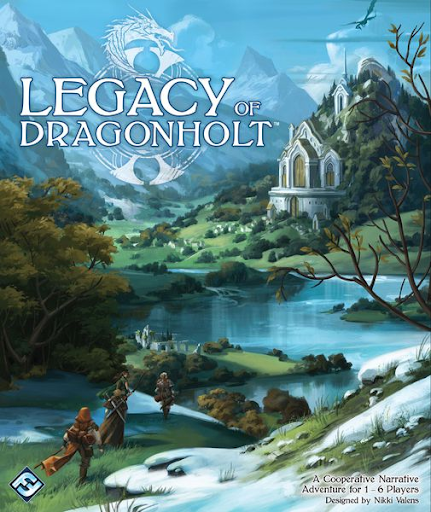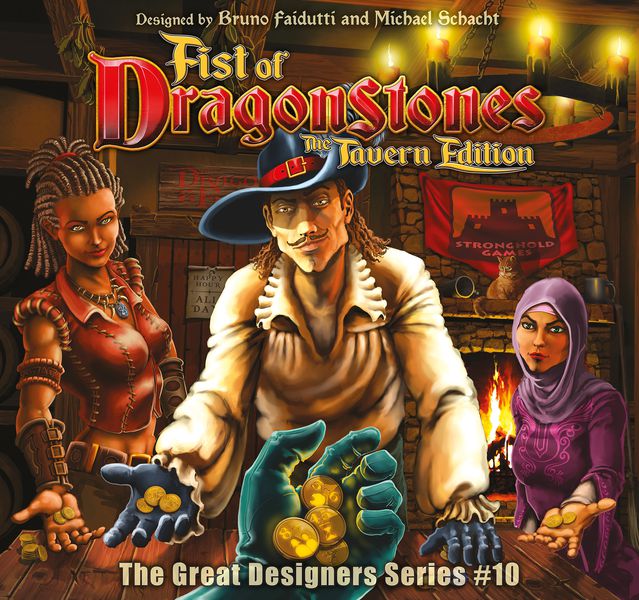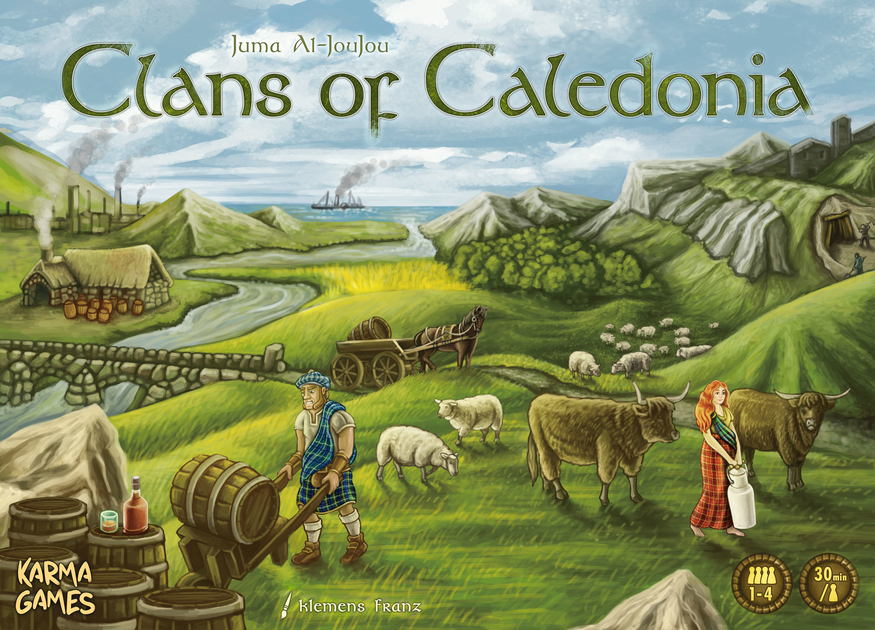KOI
Published by Smirk and Laughter Games - 2018
Designer: Bill Lasek
Head Artist: Christy Freeman
2 - 4 players ~ 30 - 45 minutes
Review written by Luke Muench
We, as people, strive for various goals in our lives. To get the dream job, get married, have a house, grow old with your loved ones, and so on. There’s so much to work for in this world, and sometimes it can be hard to choose what to dedicate your time and energies towards.
Little did I know, koi fish know way better than the rest of us. Their goal, according to ancient Japanese legend, is to be the strongest one that ever was, to swim upriver against all odds, and to one day transform into a dragon. A freaking DRAGON. I mean, come on, what more can you ask for?
KOI asks you, the player, to live out that legend, eating various animals to grow strong in hopes of eventually reaching that pinnacle of fishy transformation. The question is, does it build to a spectacular fin-ish, or does it drag-on for far too long?
Disclaimer: KOI was designed by my friend, Bill Lasek, whom I’ve gotten to know over the course of two or three social gatherings. This relationship will not impact my thoughts on the game.
Disclaimer #2: This game was provided for review purposes by Curt Covert of Smirk and Laughter.
Disclaimer #3: No, I’m not sorry for the puns. Thank you for pun-derstanding.
Hungry Hungry Koi Fish
“Don’t fashion me into a maiden that needs saving from a dragon. I am the dragon, and I will eat you whole.” - Anonymous
KOI features a fairly easy and straightforward gameplay loop. Each turn, players will have the opportunity to play as many cards as they wish out of their hand, allowing them to move their fish in specific patterns or place tokens onto the board.
The cards you play generally have a mixture of black (mandatory) movements and blue (optional) movements giving a slight amount of control over how some of your cards will play out. That said, movements are based around the direction your koi fish is facing, meaning that position and orientation are paramount to your pond-ered strategy. Players will use cards to try and twist and finagle their little pawns between rocks and around other fish, hoping to eat up dragonflies and frogs, awarding players 3 points and 1 point respectively. Seeing as this is the only way for players to earn points, quickly your fishes consumption will draw the most focus.
Placing tokens, however, can assist in your efforts or thwart those of others. Placing rocks in the board creates obstacles that fish need to make their way around. Lily pads spawn dragonflies each round, creating more ways of earning points. Frogs eat all adjacent dragonflies, screwing other players out of points while also providing small amounts of points themselves. And flowers create shockwaves throughout the pond, pushing various tokens here and there.
If players feel like they don’t have any cards of value in hand, they can always discard as many cards as they wish, drawing back up the same number of cards minus 1. This can, on occasion, allow you to do things when you may otherwise be stuck, but it’s often the least appealing option, even if it means you floundering around for a turn or two.
Players draw three cards at the start of each round barring the first, meaning you’re aware of your steady income from the get-go; it comes down to how you budget and use said cards. Do you hold off and play no cards this turn, banking on a big play in a couple of turns, or are you going to consistently spend all your cards each round? This flexibility can lead to some creative plays that can spice up any turn of the game, leading to some “oh snap!” moments that ripple through the players at the table.
The last little aspect of the game is the weather cards, which are drawn at the beginning of rounds, applying global effects and changing how each player may approach their turn. This can keep things fresh and tend to add cute little additions to your average turn.
The game plays out for 7 rounds, after which whoever has the most points wins. Sounds like a pretty straightforward game, right? And it is… until its not.
Swimming Upstream
“A dragon is not a slave.” - Daenerys Targaryen
It only takes a couple of turns before players start to feel restricted by their hand size and, more importantly, what cards they draw into. It’s completely possible to draw no movement cards on a turn, and just as plausible to draw into movement cards that will force you off in an unrelated and inane direction. Obviously, this is a function of the game, as you can’t just swim where you please, but it can feel frustrating; one player will likely be doing better than another not based on their skill or foresight, but based on what cards they happened to draw into.
In this same vein, a number of cards exist solely to screw with other players, a staple of the Smirk and Dagger repertoire for sure, but when your hand of options are so limited, it can feel like an uphill battle. At the end of the day, obtaining dragonflies and frogs are all that matter, so if you’re not gaining any on your turn, even if you’re preventing others from doing the same, it can feel daunting and uninvolved.
That being said, the Smirk games have always been lightweight in their design, made to be more goofy and fun than competitive, especially the Laughter line of games. KOI is clearly meant to appeal to audiences who aren’t as concerned over winning as I am.
One rule, however, stands out particularly in terms of its complexity when compared to the rest of the game. When the aforementioned flowers force various pieces across the board, each token has its own rules when interacting with other objects, requiring you to flip through the rulebook to a chart listing how each thing should move, sending the game you’re playing to a shuddering halt. This is only made more confusing when you realize that if a flower pushes another flower on the board, that 2nd flower then activates as well, creating a potential cascade of chaos as you try and determine how everything moves and in what order they all move in.
I’ve been forced to reference the rules a surprising number of times when playing through KOI, which is a bummer when the game prides itself on being easy to pick up and play.
For me, though, my biggest issue with the experience was the amount of time it took players to take their turns. See, each player has at least 3 cards each turn that they have to figure out how to chain together. Each card then may have optional movements that you have to choose whether or not to take. Then you have to consider when to drop certain objects on to the board, knowing that it may mess up your movement, provide others with an advantage, or that the timing of this is crucial to allow you to get where you need to be headed. Top this off with the constant question of whether or not to discard cards to try and get better ones, and KOI consistently fostered a feeling of analysis paralysis. For some, this may not be a big deal, but I found it a bit tedious, especially if you have to wait on 3 other players.
Rising Above It All
“You must have a dragon hidden inside you. When you need, you let the dragon out.” - Anderson Silva
Now, this might ultimately sound like a negative review, which admittedly, you have every right to think so, but here’s the thing; I play games primarily to socialize and to outwit my opponents in games. KOI doesn’t really offer me an opportunity to do either. When it comes to socialization, everyone has their heads buried in their cards as they try and math out just how to shift and move their little koi boi across the map. And in terms of outwitting others, it doesn’t feel smart to have an opponent play a card that you had no idea was coming, it just feels a bit random.
So it makes sense for me not to be highly invested in what goes on in KOI; I’m simply not the audience for it.
Other players, however, have had a blast with this title, and I can see why people can and will enjoy this game. It’s silly, has that take-that element to mess with your friends, the art is absolutely stunning.
If there is one thing that I can unequivocally praise about this game, it’s that it has incredible art and components. The sprawling board is lovely to look at, the tokens give it a nice cohesive look as the board gets more and more added to it throughout a game.
So, as long as you can sit back with some beer and pretzels and not take it all too seriously, or you want a beautiful looking game that has some strategy but a simple enough ruleset that kids could engage with, KOI can be a calming time to spend an evening with friends and family.
Who Should Get This Game: Those who are wooed by the production value and don’t mind lighter games
Who Shouldn’t Get This Game: If you’re bothered by luck of the draw, occasionally repetitive turns, or having to reference the rules more than once per game, this might not be the title for you.
A review copy of Koi was provided by the publisher.
Got questions about the game, the review, or the creative process? Let us know any we may tackle it when we publish our audio version with additional thoughts and Q&A on TCbH Reviews.
The Cardboard Herald is funded by the generous support of readers, listeners, and viewers like you. If you'd like to see more content like this, you can support us on Patreon here.
Other Recent Reviews:



































